Our last evening in Luang Prabang was a great one. Darryl and Christine (the couple we met in Nong Khiaw) had arrived in town that afternoon, so we all met up again in the evening for dinner. Wanting to set off relatively early the next day, we were not out late, but it was great to see them again and catch up. Hopefully we will see each other again somewhere on the road.
The next morning we were up and on our way early as planned. However, we hit a snag after around twenty miles, when Oli noticed a decidedly reptilian tail hanging out from between the trip computer and the windshield. On closer inspection it turned out to be a rather beautifully patterned gecko with large yellow eyes. Said gecko was severely unimpressed with our attempts to gently evict it, and quickly ran and hid in the wiring behind the headlights, hissing and biting the stick we were using to try and scare it out. There was no way it was leaving, but after making a concerted effort regardless, we decided we would have to press on and hope it left when we next had a break. It did reappear about an hour later, but our efforts to remove it once again failed as it again retreated within the bike. Thinking it may be with us for a while, Oli named him Feisty Nick.
We spent a hard day riding very twisty but beautifully scenic roads of variable quality. The scenery in Northern Laos was fabulous, and as we snaked our way towards the Thai border we were already feeling sad at the prospect of leaving it behind. We arrived at the last town before the border, and then decided that it was really too late to attempt it, and thought we might as well wait and cross the next morning. It's always very hard to predict how long a border will take, and there really was no need to rush.
The extra night in Laos turned out to be an unexpected bonus. We were staying in a basic but decent guesthouse with slightly deranged owners, but the view from the terrace was wonderful. Before going out to find food I glanced at the bike, and was surprised to once again see the tail of our lizard friend. We hadn't seen him again since we had taken a long break, so had assumed he had buggered off voluntarily. Not wanting to cause an ecological crisis by accidentally sneaking him across the Thai border, I told Oli that Feisty Nick had to go.
Evicting our gecko was no easy task. Due to where he was hiding it was necessary to remove the front panels. This is a bit of a fiddly job, and Oli was rather unimpressed as a result. We then commenced trying to gently encourage Nick out with the aid of sticks. Somewhat understandably, he did not take to this too kindly, and was putting up a spirited fight. After half an hour of patience, we managed to persuade him to change his hiding place to a pot that I held under the dashboard. On being tipped out of this he legged it away from us and into the bushes, never to be seen again. Oli declared that if it was back in the morning it was coming to Thailand.
All reptiles safely removed from the innards of our bike, it was time to find food. Judging by the friendly giggles in our direction, we got the impression that foreigners were not a regular feature at the market. However, with a combination of pointing, smiling and much amusement on both sides we managed to buy lots of fruit, fill our hungry bellies with noodle soup, and sort breakfast for the morning. A successful mission indeed.
We arrived back at our guesthouse and settled ourselves down to watch the sunset. Watching the light fade over the hills as huge bats appeared on their evening hunting rounds was a scenic and atmospheric end to a great few weeks in Laos. We had really come to love this country, and suddenly it seemed as though our time there had gone all too fast.
After a good night's sleep, we packed up the bike and swiftly rode the few remaining kilometres to the border. Exiting Laos went smoothly, and we drove through the short no-man's-land section towards the Thai side. Unfortunately the area the policeman gestured for us to park happened to be a very steep hill. As neither Oli nor I are the tallest, Oli lost his footing slightly and the bike tumbled to the side. We each stuck a leg out and caught it, but the damage was done, and there was no way that we could manage to right it from our very compromised position. Embarrassingly we had to let it go and accept falling off. This done, the friendly police officer ran over to help us pick it up. So... that was a good start.
Thankfully the rest of the process went fairly smoothly, with the exception of the customs guys not being entirely sure of what to do, which slowed us down considerably. As far as borders go it was relatively easy, and we were soon zooming along the pristine asphalt of the fabulous Northern Thai roads. This part of the country is a haven for bikers, rightly famed for its stunning scenery and super fun twisty roads. We got stuck straight in, winding our way along ridges with mountain views to both sides. Although the roads in Cambodia and Laos had been better than we had expected, this was something else, and it was great to be able to throw the bike into corners without worrying that the road might have fallen away down the cliff or something.
We arrived into Chiang Khong, a pleasant town on the banks of the Mekong, in the early evening. We found a hotel with no issues, and commenced wandering around in search of food. Thailand feels slightly crazy compared to Laos in terms of conveniences. Even the 7-11 shop was a source of wonder for us on this first day back, seeming like a land of plenty. We have found that on the road it is amazing what we get used to going without, then when it is suddenly easily available again it can make us feel slightly giddy. Thankfully we managed to cope with the excitement of 7-11, and after a wonderful dinner (oh how we missed Thai food!), we turned in early and crashed out.
The cold I had been nursing through Luang Prabang had now caught up with Oli, and he was not feeling 100% when we awoke the next morning. Deciding there was no need to torture ourselves, we thought we might as well stay put. Our hotel overlooked the Mekong river and had a lovely, airy balcony area, so there were certainly worse places to spend a day. We did very little other than relax, as our planned trip to the bicycle museum failed when it turned out to be closed. Still, Chiang Khong was an extremely pleasant town, and Oli was feeling much better for having had a rest day.
The following day we were up and ready to move, with some sightseeing planned along the way. The area we were staying in is part of the Golden Triangle, the region where the Thai, Lao and Myanmar borders intersect. This area was once synonymous with illegal opium farming, conflict, and all the other negative aspects of the drug trade. By 1994 it was estimated that as much as 80% of New York's heroin supply was originating from the Golden Triangle geographic area. It has now been cleaned up considerably, but this part of the Golden Triangle's history has not been ignored in Thailand. Due to the destructive impact of illegal opium, the King's mother set up a museum designed to educate people on its history and dangers.
The result of this was the Hall of Opium, and we decided that we could hardly drive past it without paying a visit. Not having been quite sure what to expect, we were both extremely impressed with the place. It was a well done, thoughtful exhibition. After a short introductory film, we were taken through the history of the drug with a series of beautifully done displays. It had obviously had a lot of time, thought and money poured into it, and we were very interested in this history that we knew so little about previously.
The history of opium is an interesting one. Having been in use for over 5000 years for medicinal and sometimes recreational purposes, the ancient Egyptians, Romans and Greeks were all aware of its properties. Within the Golden Triangle, it was grown as a medicine for at least the past 1000 years, and although people were aware that it could become problematic in terms of addiction, it was not widely grown for more nefarious purposes until around sixty years ago. Today, opium is only grown legally in Northern India, Turkey, Australia and parts of Europe. The biggest illegal producers worldwide are Afghanistan, Pakistan, Colombia and Mexico. Within the Golden Triangle zone, Myanmar are by far the biggest producers, with Vietnam, Laos and Thailand growing relatively small quantities. The reduction of opium growth in Thailand is due not only to it being outlawed, but is also owing to efforts in assisting remote villages with switching to legal cash crops, and providing viable alternatives to poor communities.
Somewhat inevitably, the blame for the rise of opium as a non-medicinal drug can be laid almost fully on the doorstep of Western colonial powers, Britain in particular. Used to enjoying trade relationships in their favour, the East India Company and the British government were perturbed to find that the balance of trade with China was against them. This was resolved by introducing opium grown in British controlled India, leading to a huge drug addiction problem in China. By 1830, it was estimated that 12 – 13 million people were using opium, out of a population of 400 million. To put it another way, at least one out of every thirty-three people was addicted. China was quite understandably unhappy with this arrangement, and the subsequent tension kicked off what became known as the Opium Wars. Britain emerged as the victors, and unscrupulously used this advantage to force two extremely unfair treaties upon China, primarily to make it even easier to import opium. Not our country's finest hour whichever way you look at it.
The museum then moved on to look at the role of opium and later heroin in medicines, and finished by focusing on its abuse as a narcotic. We were surprised to learn about the extent to which opium and heroin were used in children's medicines in 19th century America. I suppose if anything was going to quiet a person down about their toothache, that should have done the job nicely. Aside from the slightly heavy scare tactics at the very end of the museum, the exhibition really was an intelligent and interesting way to approach a highly contentious subject. We were delighted that we had made the effort to stop by, and would certainly recommend a visit.
Sufficiently educated, we continued along our way. Oli has a masochistic love for challenging roads, so decided we would be taking the back route. This actually turned out to be a great choice. The narrow road wound up and down the mountain in a series of seemingly impossibly tight bends. For the most part we closely followed the Myanmar border, and when I say closely I mean at some points we were literally within three or four metres of it. We had incredible views to both sides, and stopped for a while on one of the ridges, looking over the Myanmar hills which stretched as far as the eye could see.
Our aim for the day was to reach the small community of Doi Mae Salong, a village spread along the ridge of a steep hill with a mainly ethnic Chinese population. Once an avid opium growing community, the area has since switched to the more legitimate crops of mushrooms and oolong tea. We settled in to a guest house and ate an enormous dinner, which was a great finish to a long day.
Before leaving Mae Salong the next day, we were keen to see some of the things for which it is famous. First up was a flying visit to a tea plantation, which had fabulous views across the hills. Tea really is a very visually pleasing crop, its rows highlighting the contours of the landscapes it grows in. Whilst it was nice, it did not take too much time, and we were swiftly on our way to our next stop.
The town of Mae Salong was originally settled by Kuomintang (KMT) forces, the 93rd Division of the Chinese Nationalist Army that refused to surrender when China was overtaken by the Communists in 1949. The nearby village of Ban Hin Taek was also the base for the Shan United Army (SUA) until they were finally ousted from Thailand in 1982, so it is fair to say that the area has a colourful history. Both groups frequently clashed with Thai government forces over their enthusiastic levels of opium farming, which once made this area a no go zone.
However, in the 1970s the KMT settlers stuck a deal with the Thai government – they would help Thailand with fighting its own communist insurgency and cease opium production, and in return the government would award them citizenship and assist them in switching to less controversial crops. The insurgency was eventually defeated, and the area was stabilised. The KMT soldiers that lost their lives are now commemorated with a museum in Mae Salong. Sadly most of the information was only in Thai or Chinese, so some of the nuances may have been lost on us, but it was interesting nonetheless.
A little way up from the museum was a small temple. We have visited plenty of Buddhist temples and stupas whilst in Asia, but the beauty of these places never ceases to captivate us. This particular example was wonderful, with a glittering gold structure rising up into the vibrant blue sky. Setting this off were some of the most ornately decorated dragons we have seen so far, which made the climb up the hill to get there entirely worth it.
From Mae Salong, it was an easy but scenic drive on to Chiang Dao. The countryside surrounding the small town looked tantalisingly lush, so we decided to try and find accommodation away from the centre. After driving a good way out of town and asking at several expensive but full places, we were starting to lose hope, and were considering heading back to town. Thankfully we spotted a sign pointing up a steep lane, and thought we might as well check it out. It turned out to belong to a wonderful set of bungalows (Baan Suan Boon), half the price of the other options and set within a charming garden. The owners have an incredibly cute daughter, who is accompanied everywhere by her friendly dog sidekick. Oli has earned the eternal love of this dog by feeding it some left over meat bones, so it now gets pretty excited whenever he appears.
Although we only planned to stay here one night, sat on the terrace this morning and looking at the views, we decided it would be foolish to rush off. We have spent the day relaxing, admiring the mountain vista, and watching the birds of prey lazily circle overhead. Tomorrow we will head on to Chiang Mai, where we have a few errands to run and jobs to do. Northern Thailand is so far shaping up to be a fabulous place to visit, and Oli is already looking forward to tackling more twisty biker roads!
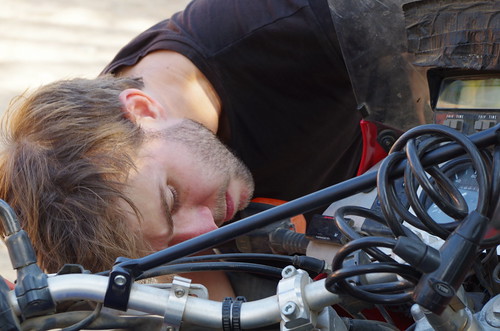

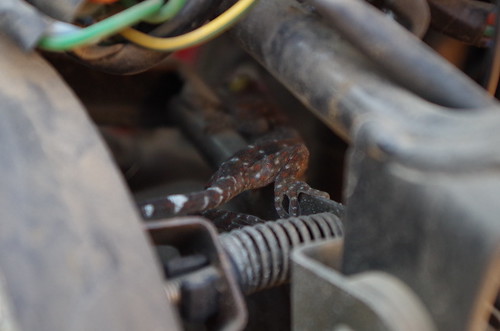

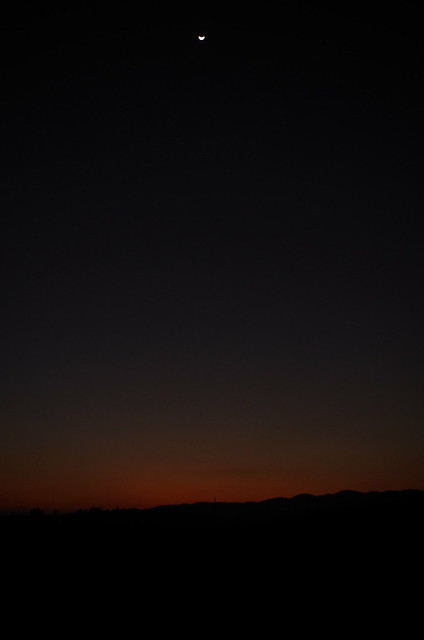
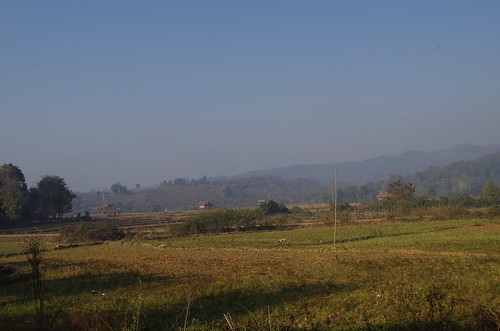
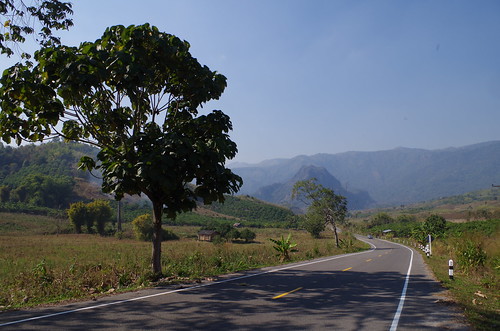

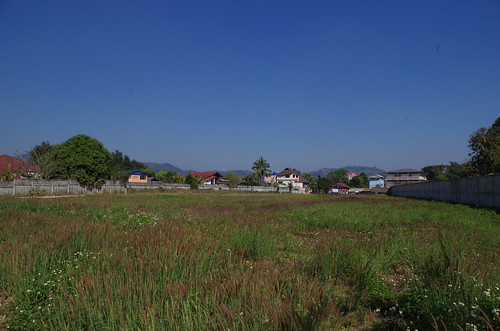
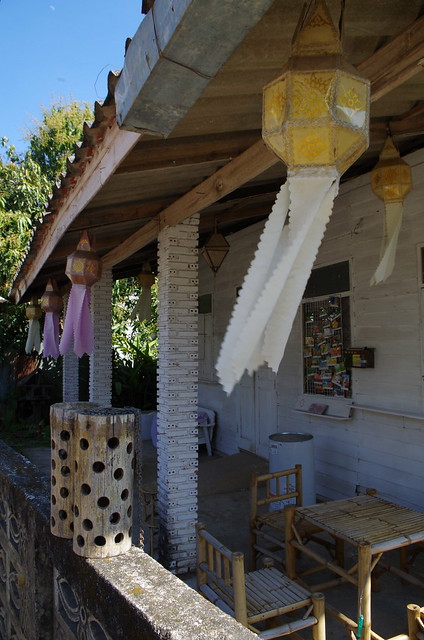

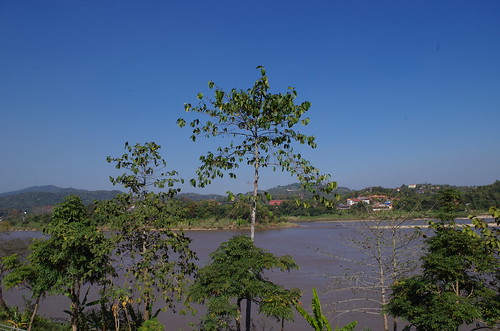
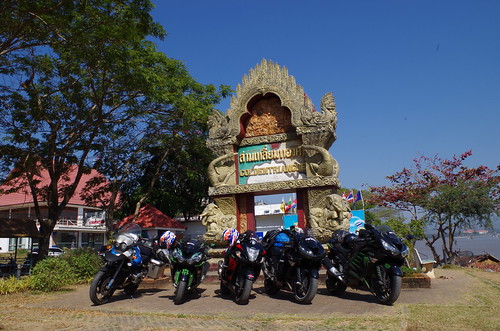


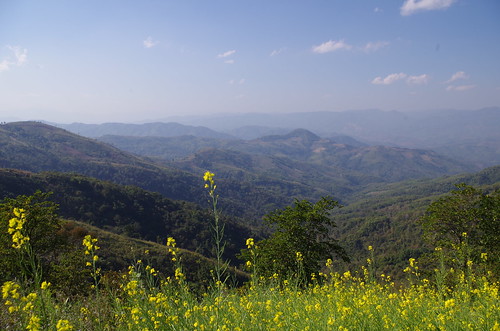
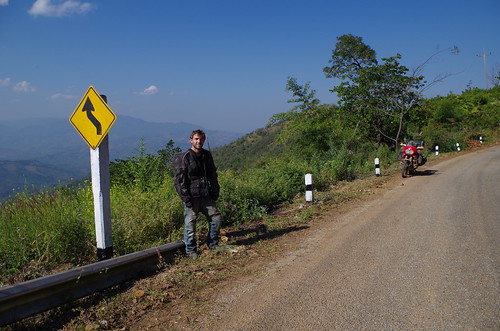
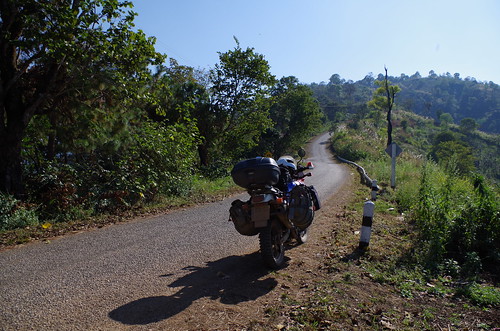


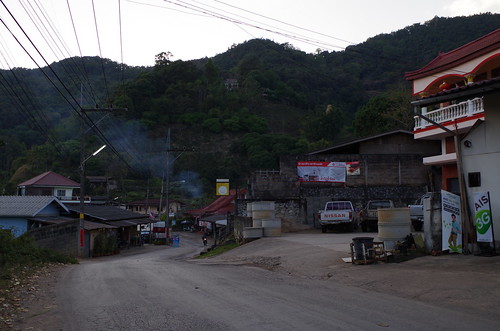

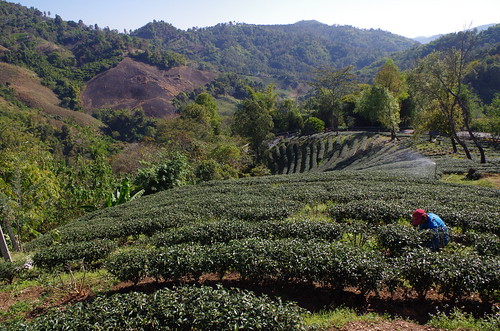
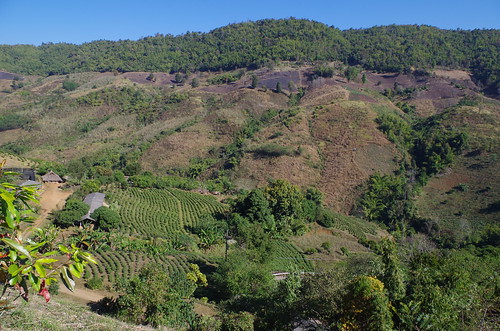
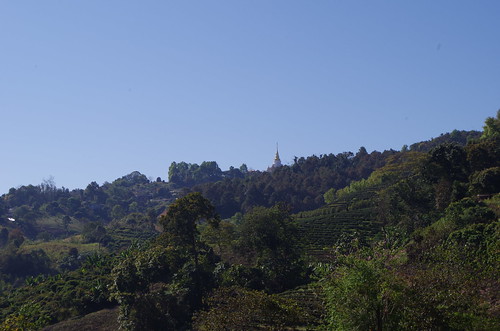

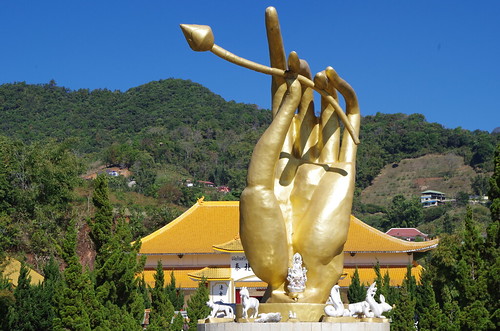
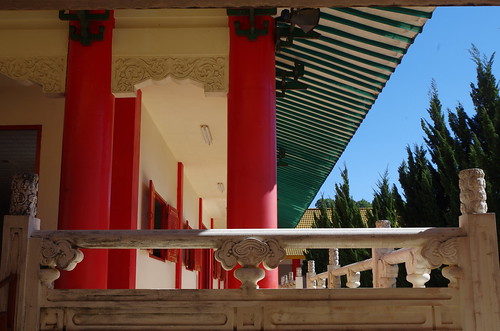
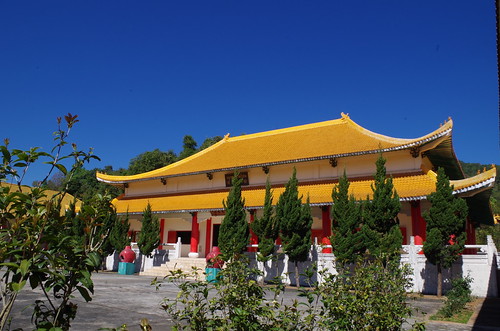

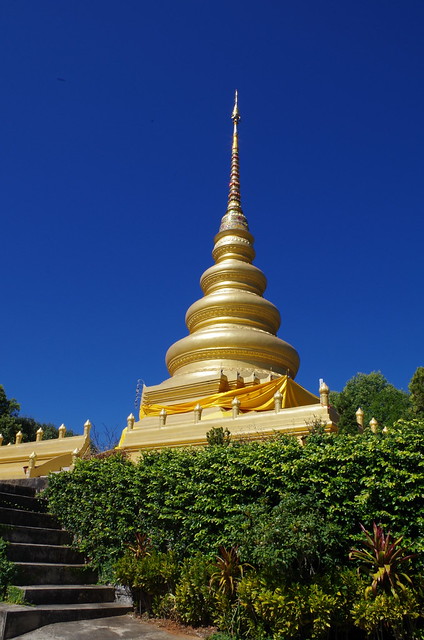






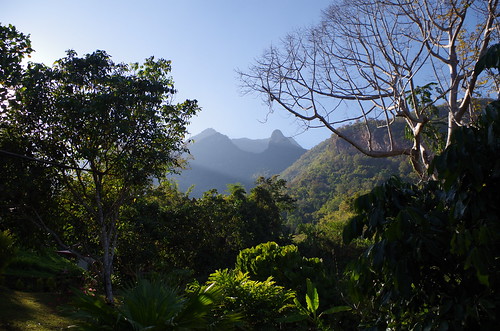
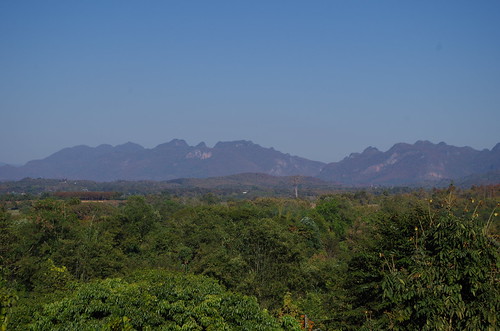
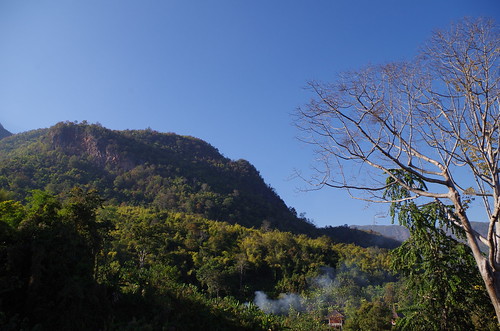



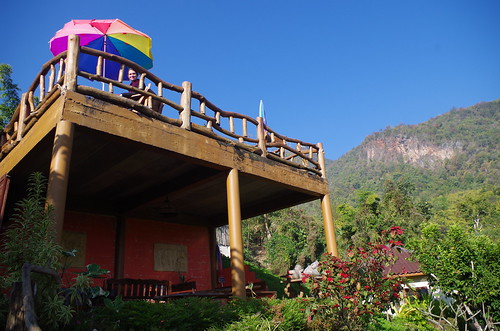
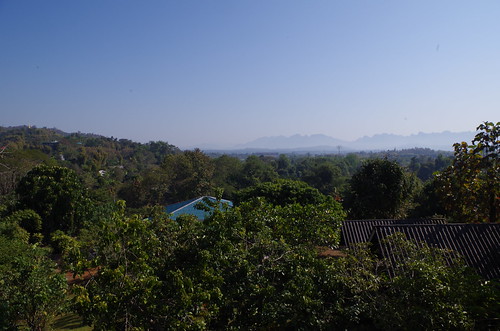
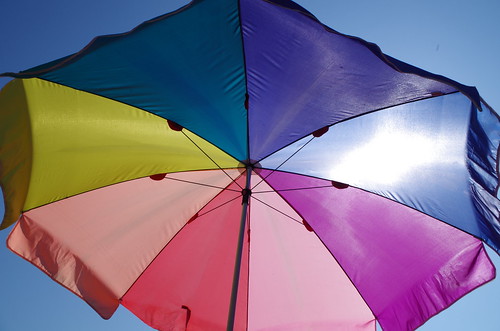
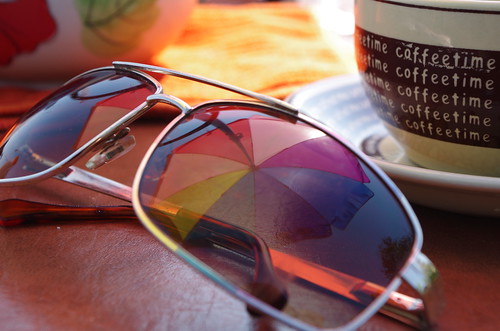
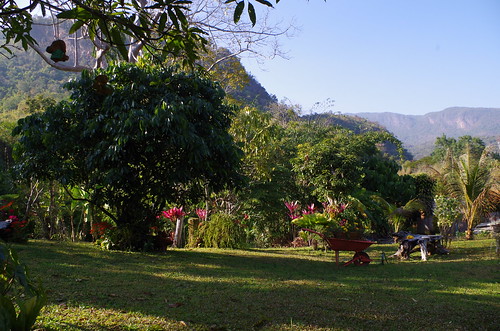
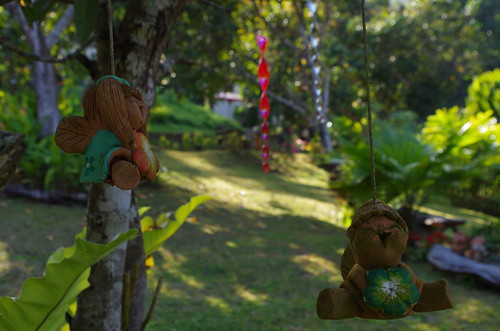

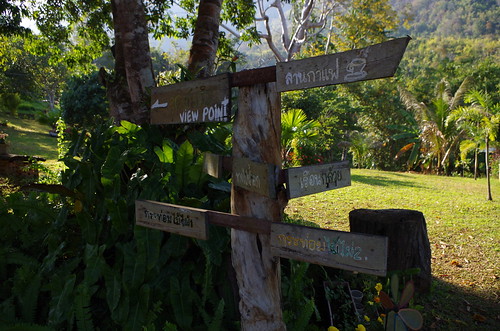

No comments:
Post a Comment